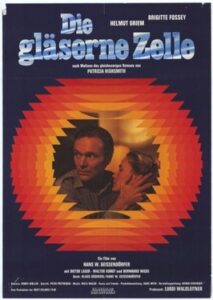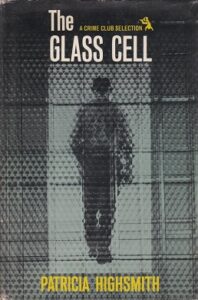Die gläserne Zelle [The Glass Cell] *** (1978, Brigitte Fossey, Helmut Griem, Dieter Laser, Bernhard Wicki) – Classic Movie Review 12,873

The understandably hard-to-please Patricia Highsmith approved of Hans W Geißendörfer’s gratifying 1978 West German crime film version of her 1964 masterwork novel The Glass Cell.
Director Hans W Geißendörfer’s Die gläserne Zelle [The Glass Cell] is a gratifying, if fairly thin, plain and straightforward 1978 West German crime film of the 1964 Patricia Highsmith novel, with not quite enough tension and not quite enough happening.
Main stars Helmut Griem and Brigitte Fossey are very effective, though, and the Seventies-style filming is interesting, with Robby Müller’s cinematography and the Frankfurt backdrops both strong assets. Its weird atmosphere and odd style are on its side, as well as its intense examination of the theme of betrayal. Hitchcock would have liked its Wrong Man plot, and the hero, an innocent man as victim, destroyed and vengeful.
Perhaps surprisingly, as crime film, it was nominated for the Academy Award for Best Foreign Language Film at the 51st Academy Awards, a sure sign and acknowledgment of quality. Indeed, again perhaps surprisingly, the understandably hard-to-please Highsmith thought well of the film, which makes many changes from the novel though keeps true to its themes and spirit.
Helmut Griem stars as architect Phillip Braun, who is released from prison after serving five years for a fatal accident at a construction site, though the shady building entrepreneur Robert Lasky (Walter Kohut) is the guilty one. Phillip returns to his wife Lisa (Brigitte Fossey) and 11-year-old son Timmie (Claudius Kracht), but everything has changed and they are both distant and strangers to him. Phillip suspects his wife has been unfaithful with his lawyer and best friend David (Dieter Laser), who keeps hanging around and promising work for Phillip and further attempts to prove his innocence. Lasky contact him and stokes up Phillip’s suspicions about the duplicitous David. David does helps him to get work, but both Lisa and David admit the affair, which turns out to be ongoing.
You kind of hope for a lost gem, but that doesn’t quite happen. It plays more like an efficient TV movie than an Oscar nominated film, though there’s nothing necessarily wrong with that. It just needs something more, something to make it special and memorable, but maybe the Patricia Highsmith novel didn’t offer the film-maker that, though her book is one of her best, very well received by critics. The hard-to-film novel is much better than the movie, but of course the film is a must-see for Highsmith fans. All it really lacks is enough urgency and energy.
In Highsmith’s perverse and subversive plot, when Phillip (Griem) kills, that’s the moment that defines Lisa (Fossey)’s love for him. And when Phillip kills again, that’s the moment that Lisa provides his alibi and saves him, and wants and needs him. They reunite at the police station, watched by the investigating police inspector (Bernhard Wicki) who knows Phillip committed two murders but can’t prove it. As usual with Highsmith, the police are conceited fools and fairly easily fooled, the guilty always going free, scot free and guilt free. Phillip feels some anger and resentment, but no guilt. He’s just tidying away the garbage and reclaiming his life and family.
Helmut Griem is a good choice as Phillip, easily able to suggest a sweet-natured and naïve young man who has been so transformed by jail that, depressed, unconcerned with conscience and easily violent, he is driven to confront those who have betrayed him. As usual with Highsmith, the male character is the fascinating one. As usual, Highsmith crosses the line, and extols the virtues of murder.
It was shot at the Bavaria Studios and on location around Munich and Frankfurt. The sets are designed by art director Heidi Lüdi.
The cast are Brigitte Fossey as Lisa Braun, Helmut Griem as Phillip Braun, Dieter Laser as David Reinelt, Walter Kohut as Robert Lasky, Claudius Kracht as Timmie Braun, Günter Strack as Direktor Goller, Hans-Günter Martens as Prosecutor, Edith Volkmann as Nachbarin, Bernhard Wicki as Kommissar Österreicher, and Martin Flörchinger.
Müller also worked as cinematographer with Wim Wenders on The American Friend (1977), a West German film of Highsmith’s 1974 novel Ripley’s Game.
Incidentally, to go scot free is to escape without incurring payment or without punishment. The term has nothing to do with Scotland, but originates from the early meaning of scot that refers to a tax assessment. Scot-free meant not having to make a tax payment and later extended to mean being exempted from other kinds of obligations, including punishment.
Helmut Griem (6 April 1932 – 19 November 2004). He is remembered for The Damned (1969) and Cabaret (1972).
Die gläserne Zelle [The Glass Cell] is directed by Hans W. Geißendörfer, is written by Klaus Bädekerl and Hans W Geißendörfer, based on The Glass Cell by Patricia Highsmith, is produced by Bernd Eichinger and Luggi Waldleitner, is shot by Robby Müller Edited by Peter Przygodda Music by Niels Janette Walen Production companies Bayerischer Rundfunk Roxy Film Solaris Film Distributed by Filmverlag der Autoren Release date 6 April 1978 Running time 93 minutes
It all started when Highsmith received a fan letter in 1961 from a prison inmate who liked her 1957 novel Deep Water. They exchanged letters and she used him for research, requesting details of daily life in prison. She then came across a journalist’s account of an innocent man’s prison experiences that provided her with more material for her 1964 novel The Glass Cell, the tenth of her 22 novels. She dedicated it to her cat Spider.
Highsmith approved of Hans W Geißendörfer’s film version of The Glass Cell, but she hated the changes he made when he went on to adapt her novel Edith’s Diary for his 1983 film Ediths Tagebuch starring Angela Winkler as Edith. Highsmith called the film ‘dreadful’ and said: ‘Making the son in love with the mother is a lot of Oedipal crap’.
Incidentally, Highsmith had a bumpy ride with her novel. Her editor at Harper & Brothers rejected the manuscript and requested major changes, and she got into a writer’s block until The Two Faces of January was accepted by Doubleday, restoring her confidence. She then successfully reworked the The Glass Cell manuscript for Doubleday.
Highsmith films: Strangers on a Train (1951), Purple Noon (1960), Enough Rope (1963), Once You Kiss a Stranger (1969), The American Friend (1977), This Sweet Sickness (1977), A Dog’s Ransom (1978), The Glass Cell (1978), Deep Water (1981), Edith’s Diary (1983), The Cry of the Owl (1987), The Story Teller (1989), Once You Meet a Stranger (1996), The Talented Mr Ripley (1999), Ripley’s Game (2002), Ripley Under Ground (2005), The Cry of the Owl (2009), The Two Faces of January (2014), Carol (2015), A Kind of Murder (2016), Deep Water (2022), Ripley (2024).
© Derek Winnert 2024 – Classic Movie Review 12,873
Check out more reviews on http://derekwinnert.com


